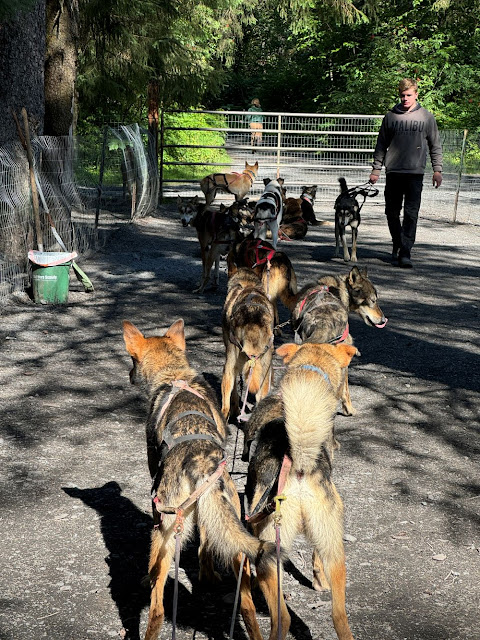The Iditarod Trail Sled Dog Race, more commonly known as the plain old Iditarod, is an annual long-distance sled dog race held in Alaska in early March. It travels from Anchorage to Nome and is about 938 miles long. Mushers and a team of between 12 and 16 dogs, of which at least 5 must be on the towline at the finish line, cover the distance in 8-15 days or more. The Iditarod began in 1973 as an event to test the best sled dog mushers and teams but evolved into today's highly competitive race. Wiki
We are going to go dog sledding or perhaps the better term would be dog carting since there is no snow.
We are heading to Mitch Seavey's (three-time Iditarod winner) racing kennel. He has about 70 dogs here, but they are only the boy dogs. The girls are at a different kennel about 80 miles away. I was so surprised when I saw the dogs, I was expecting to see dogs that looked like Huskies or Malamutes, but these dogs looked, dare I say, like your common everyday All-American dog (mutt). They took the huskies and out bred them to various breeds to get the speed and stamina they needed for racing. Dog breeds that were used were Pointers, Greyhounds, Salukis, Borzois, Labradors and Setters. These dogs were very lean and very long legged.
We were one of three carts, and we had 14 dogs to pull us along. A couple of dogs pulling us had been in Seavey's winning Iditarod team. The dogs need to be kept in shape for racing and these summer tourist pulls were a part of their fitness programs. A couple of our dogs in our line had some personality conflicts and had to be moved to different places in the line to keep the peace.
 |
| After the run, they immediately all laid down |
 |
| And there were puppies to cuddle |
After the dog sledding, we were taken out to a restaurant for lunch. I have thankfully forgotten the name of the restaurant. Let me describe my BLT. Two pieces of bread, some very thin red slice of tomato(I think), some lettuce about the size of the tomato, one piece of bacon and No, let me repeat, No mayo. I was highly disappointed but it was enough to carry on for the day.
 |
| Seward redirected a creek that tended to flood out the town. In doing so, this waterfall was created. |
We moved on to the Exit Glacier where we actually got to do a fairly short hike, but the weather was great and we got to actually get out and move around. Exit Glacier is one of the glaciers that come from the Harding Icefield in Kenai Fjords National Park. What was really interesting and depressing was the year posts that were scattered along the trail. The signs would say this is where the edge of the glacier was in 2000, this is where is was in 2014 and where the edge is in 2022.
 |
| We took the Glacier Overlook Loop Trail |
 |
| Anika made a friend |
 |
| Ravens were all over the place. Big, big birds. |
 |
| Exit Glacier - all that greenery and rocks used to be covered with ice. Notice the little people in the lower right. I think the glacier sort of looks like a ski run at the end of the snow season. |
When the day was done, we hopped back on the train for dinner and to go back to the same hotel that we stayed at previously in Anchorage, the Lakefront Lodge. We got upgraded from having a view of the parking lot to a big brick wall.





OMG, what fun to follow you. We were just in all these places! Have a great time. But beware, the fireweed blooms are are the top of the stem.
ReplyDelete